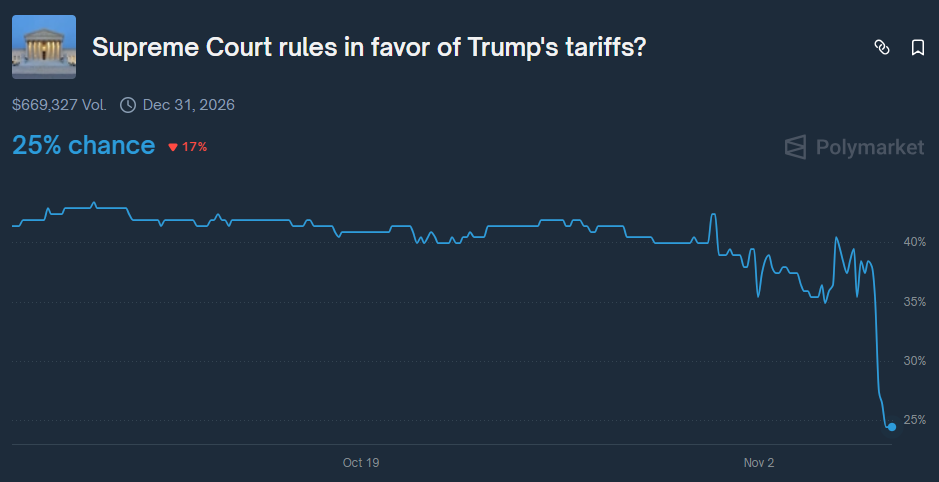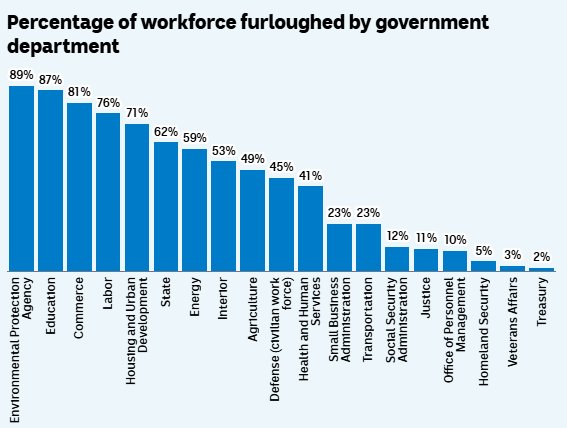Berita & analisis pasar
Tetap selangkah lebih maju di pasar dengan wawasan ahli, berita, dan analisis teknikal untuk memandu keputusan trading Anda.

Artificial intelligence stocks have begun to waver slightly, experiencing a selloff period in the first week of this month. The Nasdaq has fallen approximately 2%, wiping out around $500 billion in market value from top technology companies.

Palantir Technologies dropped nearly 8% despite beating Wall Street estimates and issuing strong guidance, highlighting growing investor concerns about stretched valuations in the AI sector.
Nvidia shares also fell roughly 4%, while the broader selloff extended to Asian markets, which experienced some of their sharpest declines since April.
Wall Street executives, including Morgan Stanley CEO Ted Pick and Goldman Sachs CEO David Solomon, warned of potential 10-20% drawdowns in equity markets over the coming year.
And Michael Burry, famous for predicting the 2008 housing crisis, recently revealed his $1.1 billion bet against both Nvidia and Palantir, further pushing the narrative that the AI rally may be overextended.
As we near 2026, the sentiment around AI is seemingly starting to shift, with investors beginning to seek evidence of tangible returns on the massive investments flowing into AI, rather than simply betting on future potential.
However, despite the recent turbulence, many are simply characterising this pullback as "healthy" profit-taking rather than a fundamental reassessment of AI's value.
Supreme Court Raises Doubts About Trump’s Tariffs
The US Supreme Court heard arguments overnight on the legality of President Donald Trump's "liberation day" tariffs, with judges from both sides of the political spectrum expressing scepticism about the presidential authority being claimed.
Trump has relied on a 1970s-era emergency law, the International Emergency Economic Powers Act (IEEPA), to impose sweeping tariffs on goods imported into the US.
At the centre of the case are two core questions: whether the IEEPA authorises these sweeping tariffs, and if so, whether Trump’s implementation is constitutional.
Chief Justice John Roberts and Justice Amy Coney Barrett indicated they may be inclined to strike down or curb the majority of the tariffs, while Justice Brett Kavanaugh questioned why no president before Trump had used this authority.
Prediction markets saw the probability of the court upholding the tariffs drop from 40% to 25% after the hearing.

The US government has collected $151 billion from customs duties in the second half of 2025 alone, a nearly 300% increase over the same period in 2024.
Should the court rule against the tariffs, potential refunds could reach approximately $100 billion.
The court has not indicated a date on which it will issue its final ruling, though the Trump administration has requested an expedited decision.
Shutdown Becomes Longest in US History
The US government shutdown entered its 36th day today, officially becoming the longest in history. It surpasses the previous 35-day record set during Trump's first term from December 2018 to January 2019.
The Senate has failed 14 times to advance spending legislation, falling short of the 60-vote supermajority by five votes in the most recent vote.
So far, approximately 670,000 federal employees have been furloughed, and 730,000 are currently working without pay. Over 1.3 million active-duty military personnel and 750,000 National Guard and reserve personnel are also working unpaid.

SNAP food stamp benefits ran out of funding on November 1 — something 42 million Americans rely on weekly. However, the Trump administration has committed to partial payments to subsidise the benefits, though delivery could take several weeks.
Flight disruptions have affected 3.2 million passengers, with staffing shortages hitting more than half of the nation's 30 major airports. Nearly 80% of New York's air traffic controllers are absent.
From a market perspective, each week of shutdown reduces GDP by approximately 0.1%. The Congressional Budget Office estimates the total cost of the shutdown will be between $7 billion and $14 billion, with the higher figure assuming an eight-week duration.
Consumer spending could drop by $30 billion if the eight-week duration is reached, according to White House economists, with potential GDP impacts of up to 2 percentage points total.


All Eyes on Jackson Hole Economic Symposium The annual Jackson Hole Economic Symposium is sponsored by the Federal Reserve of Kansas City and is annually held in Wyoming. It is an exclusive central bank conference which fosters open discussions on global policy matters. The event is closely watched by market participants and has the potential to affect the stock and currency markets.
A Pivotal Moment for Volatile Markets There is no doubt that this event will likely be the most important one for the global markets this week. However, what makes it more special and relevant this year is how appropriately the title “Challenges for Monetary Policy” reflects the reality of the recent challenges faced by policymakers. Investors have been navigating in an extremely volatile environment in the past few weeks, gripped by mounting worries of recession and trade tensions that are threatening the harmony of the global trade system.
Challenges for Monetary Policy Ten years after the financial crisis, monetary policymakers are forced to look back and assess the challenges of normalising monetary policies. Over the years, central banks across the globe have used both conventional and unconventional monetary policies to support their domestic economy in the face of the financial crisis. However, the current headwinds and inflation dynamics are making it difficult for policymakers to chart a course of monetary policy and begin removing policy accommodation.
Only a year ago, central bankers were talking about rising interest rates. A global slowing economy on top of trade tensions is forcing them to seek refuge with more easing monetary policies. Despite steady economic growth over the years, global interest rates have not been able to return to levels seen before the financial crisis. “Midcycle Adjustment” Market participants are eagerly waiting for the Federal Reserve Chairman, Jerome Powell, to deliver its speech on Friday.
The July rate cut was less-dovish than anticipated as the Fed Chair surprised the markets with a “midcycle” adjustment. A lot has happened since his last remark. We saw recession fears crawling back in the financial markets which triggered a rout in the stock market, and a rally in the bond market.
The 2-Yr US government bonds dropped below the 10-Yr yields for the first time since the financial crisis. The 30yr Treasury Yield also briefly fell to a record low. The Symposium will help market participants assess and process the meaning of “midcycle” and see if the Fed will adjust their remarks following the recent developments in the markets.
Investors are also hopeful to see the comments on the recession risk. So when Jerome Powell delivers his annual speech at Jackson Hole this Friday, he can either calm nerves or create more panic.


The Australian share market struggled to edge higher despite overnight gains on Wall Street. The S&P/ASX200 dropped on the open after a two-day advance as all three US equity benchmarks had pared gains in the final hours of trading dragged by dovish Fed comments. In the afternoon, the index was down 37 points or 0.70% to 5,370.
All Ordinaries was trading lower by 28 points or 0.51% to 5,450. The majority of the sectors were trading in negative territory but significant losses of more than 1% were seen in the real estate and financial sectors. Bank stocks were heavily weighing on the index with Westpac, ANZ and NAB all down by 2% or more, while CBA was trading around 1% lower.
Source: Bloomberg As of writing, the energy sector was the best-performing sector, supported by a surge in crude oil prices. For the first time since April, Brent Crude oil futures rose above $30 as production cuts started kicking in. Source: Bloomberg On the economic front, the Aussie Retail Sales turnover came above expectations at 8.5% in March compared to the 8.2% forecasted.
Australia saw both record rises in food retailing and record falls in cafes, restaurants and takeaway food services. Panic-buying has driven the increases in food retailing (24.1%), household goods retailing (9.1%) and other retailing (16.6%) which has helped to compensate for the significant drop in other categories. The Aussie dollar remains relatively muted at 64.30 US cents, despite the upbeat Retail Sales data.


A Cautious Fed FOMC Meeting Investors were eagerly looking forward to the Fed’s statement and forecasts for clues on how the Fed is viewing the health of the economy after easing lockdown measures. Global central banks have played a crucial part in absorbing the pandemic-induced shocks in the global economy. Together with huge fiscal intervention, central bankers have swiftly deployed various monetary tools to keep credit flowing and provide support to businesses and households.
Dot Plots Even though the financial conditions have improved from the support of the policy measures that was put in place, the Fed highlighted that the ongoing health crisis will continue to weigh on the economic activity, employment, and inflation in the near- term and may pose considerable risks for the medium-term outlook. On Wednesday, the Fed decided to maintain the target range for the federal funds rate at 0 to 0.25%. “The Committee expects to maintain this target range until it is confident that the economy has weathered recent events and is on track to achieve its maximum employment and price stability goals.” Most importantly, market participants took note that the US interest rates will stay near to zero through 2022, ruling out the probability of raising rates anytime soon and a V-shaped recovery for the US economy. Economic Projections The Fed refrained from providing any forecasts during the pandemic given the tremendous uncertainties about the economic outlook.
Much attention was, therefore, on the interest rate and economic forecasts. Gross Domestic Product: The Fed is expecting a contraction of 6.5% in 2020, followed by an expansion of 5% in 2021 and 3.5% in 2022. Unemployment Rate: The outlook for employment is also gloomy.
After the US labour market experienced its worst monthly drop in history, the Fed is forecasting that the unemployment rate will reach a high of 9.3% by the end of 2020. Inflation: The Fed sees anaemic inflation which will remain below the target rate of 2% for the next three years. The Long Road to Recovery Markets are taking note of the long road to recovery following the FOMC meeting.
US stocks retreated as the Fed’s comments and forecasts show that they will continue to loosen monetary policy. Shares in Asia also struggled to edge higher following a cautious Fed on Thursday. World Equity Indices (% Change) Source: Bloomberg Terminal As of writing, the US and European stock futures slumped in the wake of the Fed’s decision.
Gold A dovish-Fed have pushed the precious metal to a high around the $1,740 level. Gold has been trading sideways within a $70 range amid the reopening of economies, geopolitical risks and a weaker US dollar as traders were waiting for the next biggest catalyst.


As PBOC slashed its Reserve Requirement Ratio (RRR) for large institutions and smaller banks, investors are trying to understand the rationale and implications of this action because it is the fourth cut for the year. The cut will inject billions of Yuan into the banking system. In doing so, it signals that China is worried about its slowing economy and the effects of trade tariffs.
China is facing too many headwinds at once and is trying to take pre-emptive steps to prevent investors from pulling their money out of China. The central bank announced the RRR cut after a week-long which caused Chinese markets to tumble as investors have to digest a whole week of news in one single day. CHINESE STOCK MARKETS Chinese stock markets fell more than 3.7% on Monday as a combination of proactive measures from the PBOC to ease pressure on banks and the ongoing trade tensions between the US and China did little to reassure the markets.
The decline shows that the actions did not diminish the anguish, and concerns investors have on the broader Chinese economy. The negative sentiment has also spilled to the Asian, European and US markets at the beginning of the week. The Chinese stocks have partially recovered compared to Monday, but trading in the equity markets remain wobbly.
Adding to the current uncertainties, geopolitical risks, rising US interest rates, Treasury yields and US debt deficit are also weighing on the markets. As investors reassess the growth expectations due to trade tariffs, they will most likely pay particular attention to the rising yields which could be the challenge in the next couple of weeks for the equity markets. CHINESE YUAN The move accentuated the bearish momentum of the Yuan.
Beijing struggled to keep its currency afloat as it has weakened beyond the 6.93 handle. Most Asian currencies were also weaker on Monday because of the RRR cut and the rising US dollar. As the pair moves toward the 7.00 mark, the risks that emerging markets will go down with the fall in the Yuan increases.
While trade uncertainties is a major contributing factor in the depreciation of the Yuan, the currency is battling a lot of headwinds at once. Traders will likely keep a close watch on the key psychological level of 7.


US Government Shutdown President Trump has agreed to temporarily end the shutdown, putting an end to the most extended shutdown in US history. The three-week pause initially lifted investor sentiment and helped Asian stocks push higher on Monday’s open. It is reported that the shutdown cost the economy $11 billion, which includes approximately $3 billion of permanent loss.
Economists are predicting a drop of 0.2% in GDP for the first quarter of 2019. There are still some negative effects that may not immediately be identified or quantified at this stage. Despite the temporary halt, there are a number of reports such as new home sales, construction spending, durable goods and factory orders are being postponed.
The release of fourth-quarter GDP data which was initially scheduled for Wednesday will be delayed. However, the monthly non-farm payrolls reports will still be issued on Friday. The data void has made it difficult for traders and the US Federal Reserve to assess the health of the US economy.
The FOMC will hold their first meeting on Wednesday, and the lack of economic reports can compromise their outlook. US-China Trade Talks The trade talks resume this week amid the chaos surrounding the criminal charges against Huawei’s CFO. Both parties are facing increasing pressure to come to a trade deal as China’s economy is taking a hit and President Trump need to deliver some of its election promises especially as the funding of the Wall is on hold.
Investors will probably monitor any information/headlines emerging from the high-level groups of delegations. The willingness to engage has increased the chances of some sort of a deal, but it is unlikely to be a quick- fix. Since the start of the year, there is more optimism on the trade talks, but the reality in the state of negotiations are still far from conclusive given the looming deadline.
Earnings Season It will be a busy week with more than 300 companies reporting earnings. After Caterpillar missed estimates for the first time in a decade and Nvidia downgraded revenue forecasts, investors appear to be on edge as it has exacerbated fears of slow global growth. Apple will release earnings on Tuesday while Boeing, Microsoft and Visa earnings are due on Wednesday.


Theresa May suffered the worst defeat in recent times in British history. The House has spoken, and Theresa May stated that the government will listen. “It is clear that the House does not support this deal, but tonight’s vote tells us nothing about what it does support.” It will be a big challenge for her to negotiate a withdrawal agreement with the European Union if the UK seems confused about what they want themselves. What’s Next? is the number one question emerging after the big defeat.
Labour’s Leader, Jeremy Corbyn has tabled the motion of No-Confidence. Today will be another busy day for Britain: 1:00 PM (London time)– Jeremy Corbyn will open the debate and Theresa May will debate the motion. 7:00 PM (London time) – The Vote will take place. 7:15 PM (London time) – The Result will be out. Out of 650 MPs, Theresa May will require 318 votes to win.
The result of the no-confidence vote will determine the next course of action: At this stage, we believe that the government have higher chances of surviving the vote. The conservative rebels do not want a change of government but want a change of policy rather. It is unlikely that her Conservative Party will risk Labour winning and Jeremy Corbyn becoming Prime Minister.
In the case, the Labour Party fails to trigger an election, they will attempt to seek a second referendum as discussed in my previous article. Tonight’s No confidence vote will provide more clarity on the next course of action. In the meantime, we continue to expect wild swings in GBP pairs.
The Pound pumped back the heavy losses made against major currencies after the vote, and we believe such volatility is normal given the circumstances and uncertainties grasping the markets around the next steps of Brexit. However, now that the likelihood of a no-deal Brexit has reduced, giving room to more alternative plans, the direction of the Pound appears less skewed to the downside. A look at the long Doji candle on the daily chart of the GBPUSD pair shows that bulls are providing strong support to the pair.
GBPUSD Source: GO MT4

